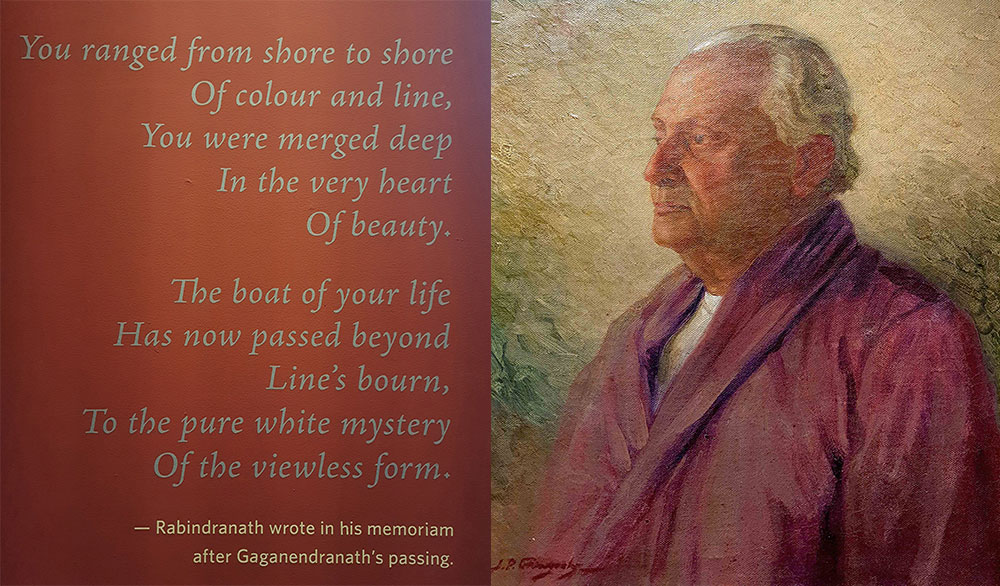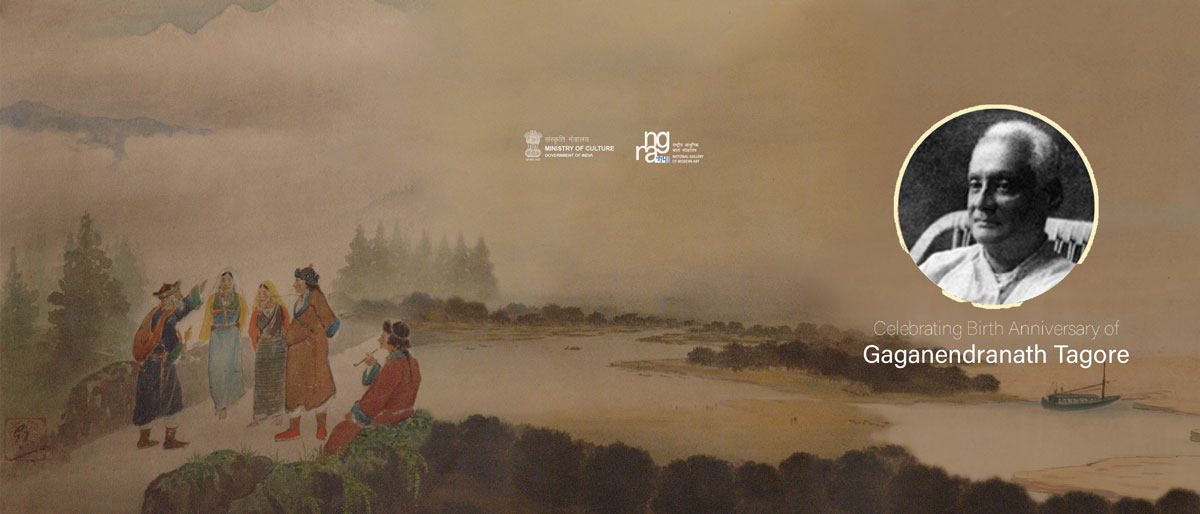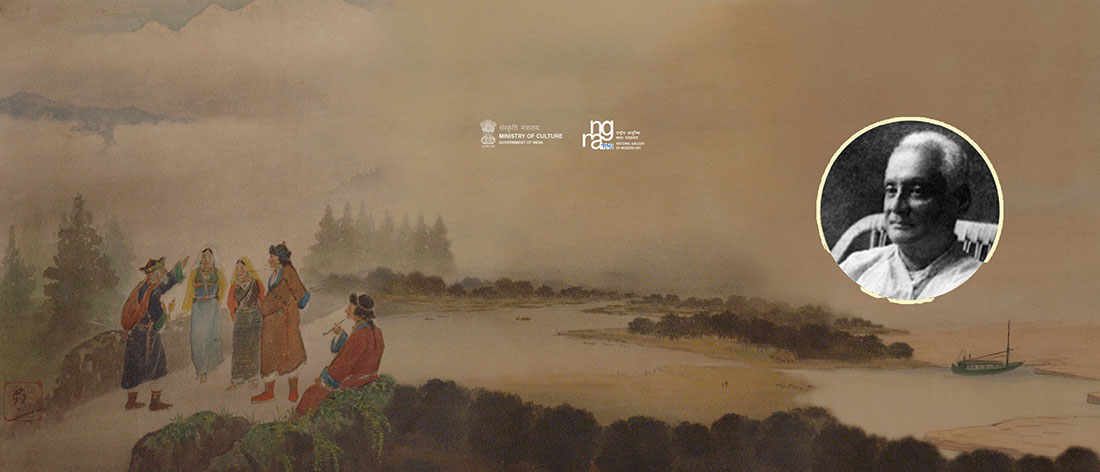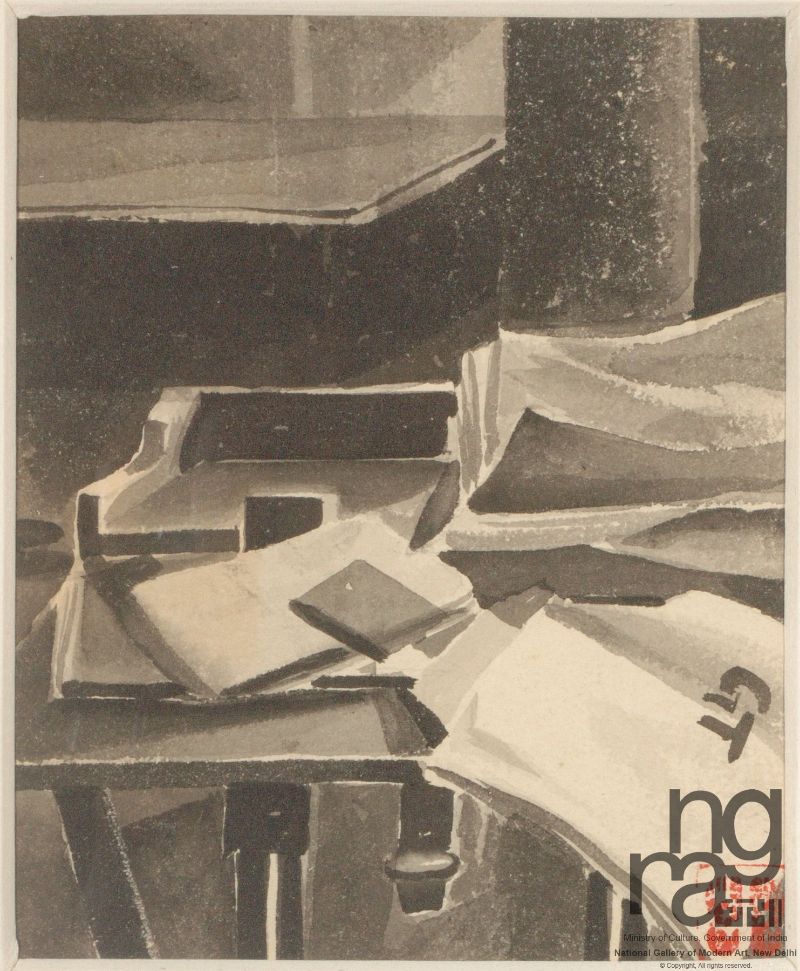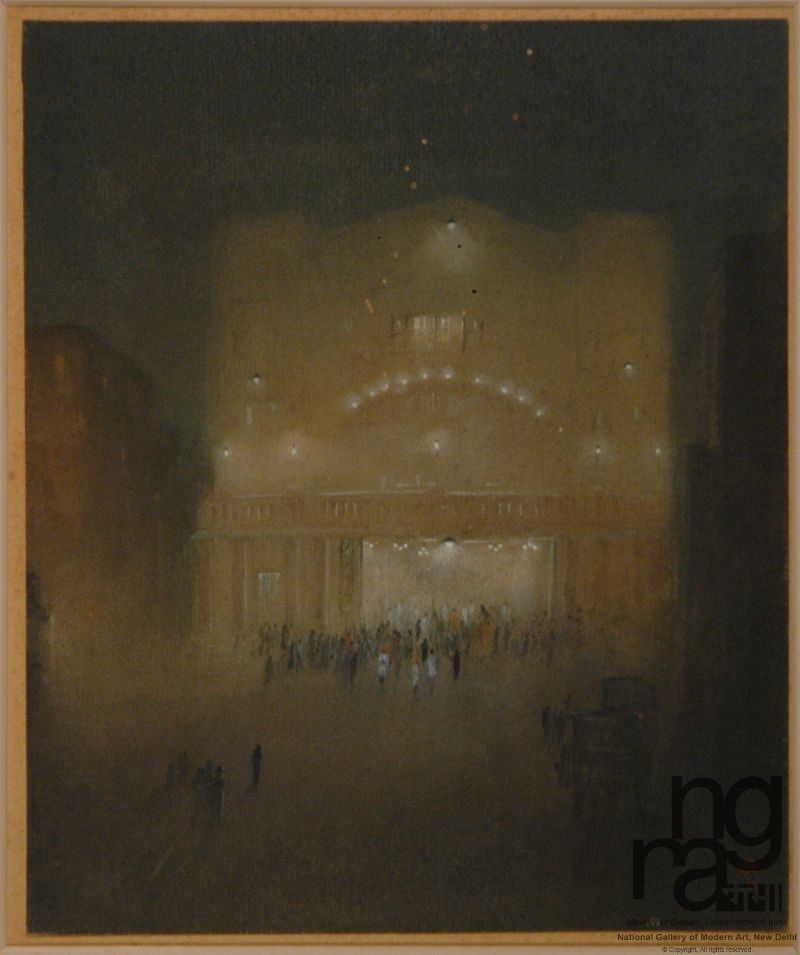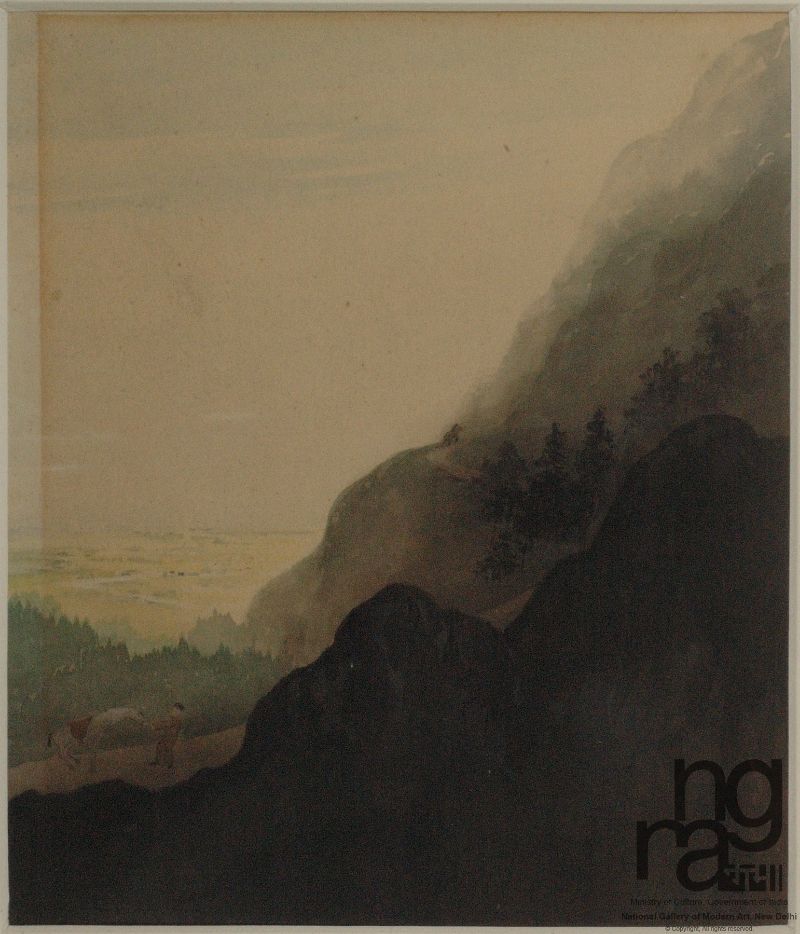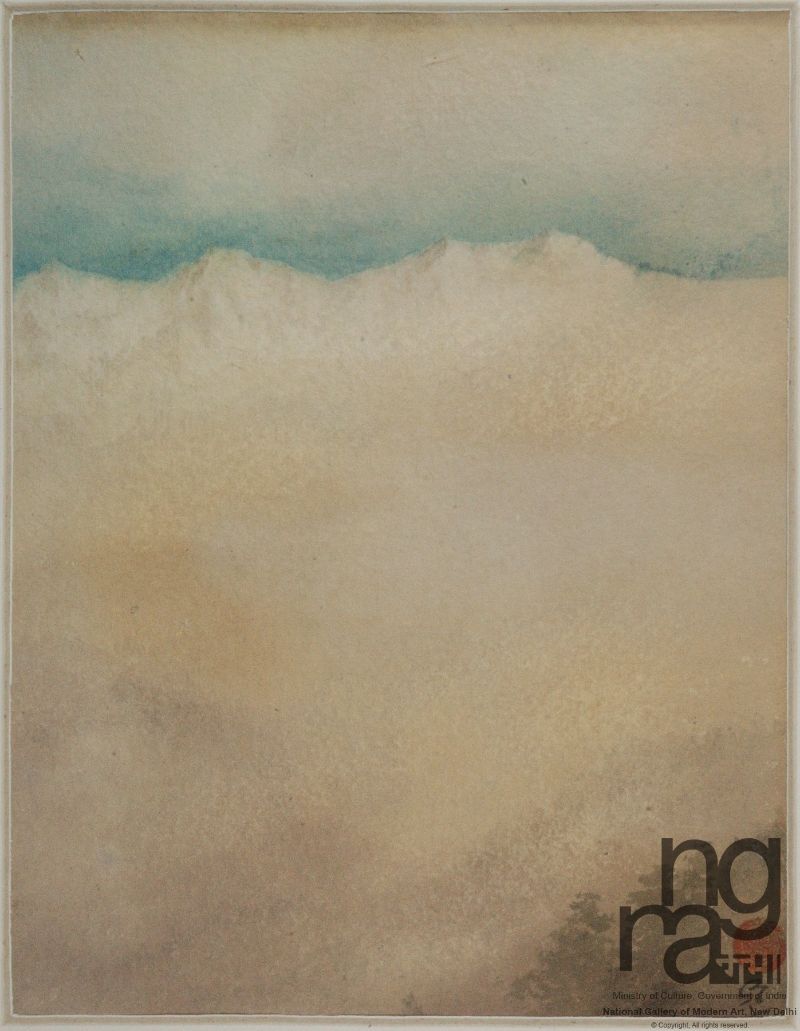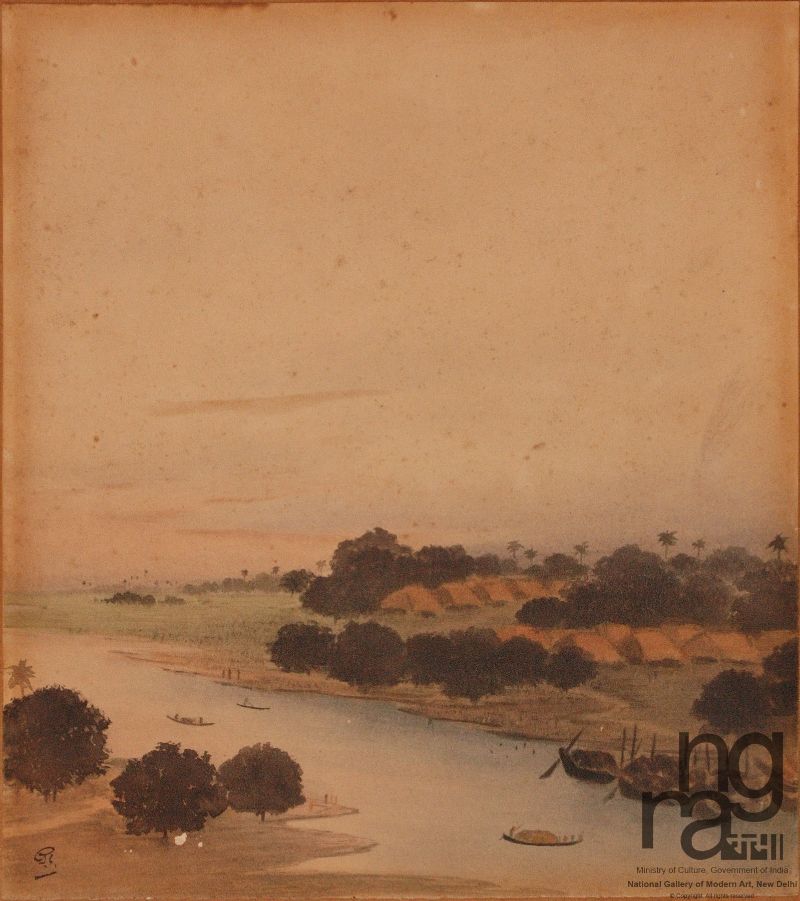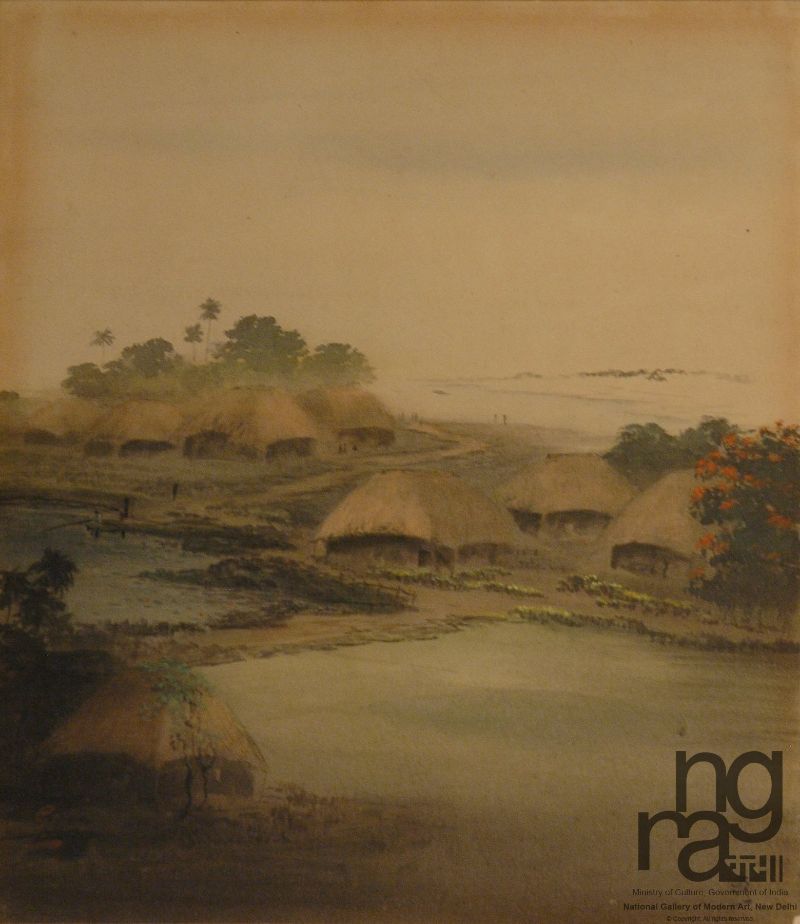Back Virtual Tour | Reminiscences : Gaganendranath Tagore
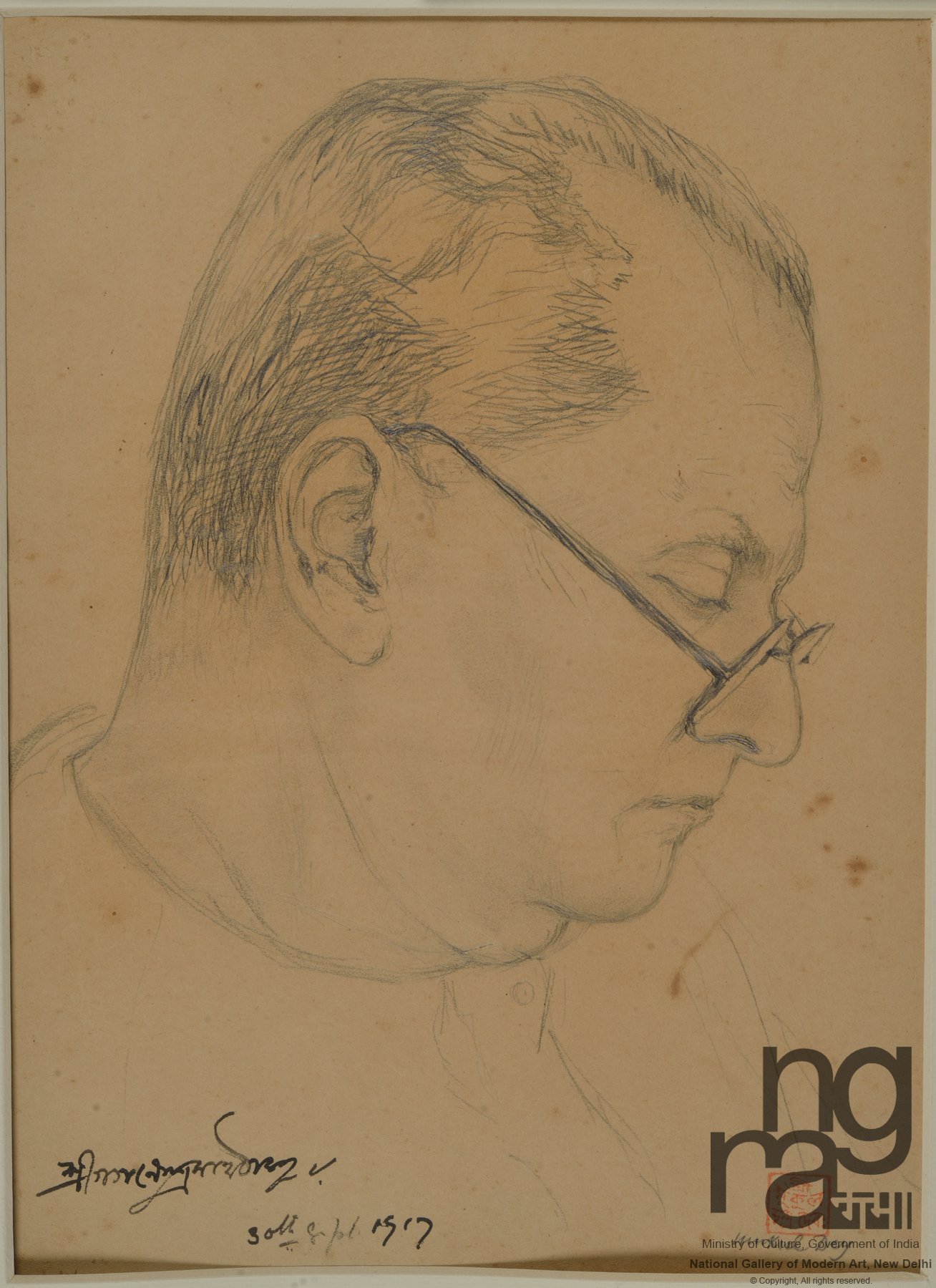 Accn. No.01496 | Gaganendranath Tagore | Pencil on paper | 25.3 X 35.5 cms | by Mukul Dey
Accn. No.01496 | Gaganendranath Tagore | Pencil on paper | 25.3 X 35.5 cms | by Mukul Dey
Reminiscences : Gaganendranath Tagore
(17.09.1867 – 14.02.1938)
Tribute to the iconic artist on his 154th Birth Anniversary
Artist's Profile
Born to the family of Tagore's of Jorasanko, Kolkata, Gaganendranath was the elder brother of Abanindranath Tagore. With little formal training in art Gaganendranath began painting at an advanced age. He was inspired by the calligraphic brushwork and the wash technique of the visiting Japanese artists, Yokoyama Taikan and Hishida Shunsho. In the early 20's of the Twentieth century, Gaganendranath responded positively to the European modernist idiom. He began painting seriously when he started illustrating his uncle Rabindranath Tagore's autobiography in 1911. Gaganendranath like his younger brother Abanindranath and uncle Rabindranath had a wide range of interests that covered theatre, fantasy and the like. He also practiced photography and this can be seen in the use of light and shadows in his paintings. From 1917 onwards he did a series of satirical caricatures of changes taking place in the society of his times. Many of his paintings were referred to as 'cubist' because of the division of the figures and ground into geometrical planes. Gaganendranath painted portraits, landscapes, caricatures, abstract and 'cubist' paintings.
Gaganendranath was closely associated with his brother Abanindra in the creation of the Revivalist School of Bengal. But he never allowed himself to be influenced by any of the traditions or styles of Indian art which a large number of artists of the country were following in the wake of this new art movement. He found guidance and the goal for his art in nature and in the environment around him, and produced paintings bearing a stamp of strong individuality. He took to painting seriously rather late, and remained an active painter for not many years, as a sudden illness incapacitated him for the last ten years of his life. But within this fairly short span of active life he was very prolific in producing sketches, drawings by the hundreds in pen and brush, and many water color paintings. From his early youth Gaganendranath had a regular habit of making quick and successful of fleeting gestures and expressions of people around him. So when he started painting in earnest his brush yielded mature works straight away.
His early paintings were landscapes – mainly from memory, and figure compositions, many of which illustrated the life story of Shri Chaitanyadeb. These compositions generally show line drawings in a background of soft tone and tinted with delicate colors. He also produced several caricatures in the vein of social satire. These were bold in conception and showed excellent draughtsmanship, but were without any malice or bitterness. They were produced almost as farces befitting the stage to amuse the spectator and make them laugh.
At the Tagore residence in Calcutta plays were written, staged and acted by the members of the family. Gaganendranath took part in these performances and proved himself a brilliant actor. Stage and drama must have influenced his mind profoundly, as his later paintings show an effect of stage settings and an atmosphere charged with the expectancy of the theater. From the hustle and bustle of the urban scene his vision seem to soar high into a dream land, where he could curtain off everything that was brutal and ugly, and focus an eerie light on some flight of steps, on the courtyards and parapets of a castle or on the palace of a fairy princess. Sometimes he used purely geometrical patterns in his paintings, but he never allowed himself to make a cult of it like the cubists. It was not his intention to produce these inanimate shapes as a kind of purposeless cerebral exercise. They all had a part to play in his pictures, and as we look, they seem to come to life and starts gliding, rolling and dancing before our eyes. Sometimes he would use these patterns just to produce a Kaleidoscopic effect of light, and make the glimmering rays to be deflected from facet to facet of pillars, pyramids and prisms and then to be swallowed up by semi-lucent or total darkness. In his fancy he would be a loan rider of a black horse, and visit forbidden castles or palaces of snow, or he would set out on a voyage in a dream boat in quest of far unknown lands beyond the sea. Before his gaze it seems that the visual world has lost many irrelevant details and familiar contours and that a gigantic metamorphosis has taken place. Perhaps he anticipated what was to follow after the Revivalist School. It is possible that he had a premonition before he was finally struck down by illness, for he showed us the shadow of death whispering into his ears before it drew the curtain over him. In the serenity and calmness that pervade all his works it was evident that he faced the end with courage and fortitude.
Join the Conversation
×
Research Material
Team JATAN, NGMA New Delhi
Concept, Design & Development
IT Cell, NGMA
Content Management
IT Cell
Literary Reference
Appasamy, Jaya. Abanindranth Tagore and the Art of his Times, New Delhi, Lalit Kala Akademi, 1968
Mitter, Partha. Art and Nationalism in Colonial India (1850 - 1923) Cambridge, Cambridge University Press, 1994
Gaganendranath Tagore, Indian Society of Oriental Art, 1972
The Humorous Art of Gaganendranath Tagore with an introduction by Prof. O.C. Ganguly, The Birla Academy of Art and Culture.
Guha-Thakurta, Tapati. The Making of New Indian Art, Cambridge University Press, 1992.
Sarkar, Kamal. Bharater Bhasar o Chitrasilpi, Jogmaya Prakashani, 1984.
Chintamoni Kar. Gaganendranath Tagore, Souvenir Volume Two – 1957, Academy of Fine Arts, Calcutta.
←
→
-
-
Painting
Meeting at the Staircase Acc. No. 1002 | Watercolour on paper
×
From 1922 onwards, Gaganendranath Tagore painted semi- abstract compositions where architectural elements and the handling of light played a defining role in creating a sense of mystery. Here the two female figures meet on the landing of a stairway that seems to be leading up nowhere. The image pulsates with endless narrative possibilities in the eerie evocation of light and shadows.
-
Painting
Rabindranath Tagore Acc. No. 1003 | Wash and tempera on paper
×
Gaganendranath Tagore painted many portraits of his uncle Rabindranath Tagore. Art historian Ratan Parimoo dates this work to c. 1925. Gaganendranath's fondness for using black in his paintings intensified from 1921 onwards. Not only did the artist evoke a sense of mystery and fantasy through his use of black but he also revealed his sensitivity to the play of light and its changing qualities. In this portrait, the poet's figure is softly lit by a mellow, diffused light flooding the dark interior through a square opening.
-
Painting
Portrait of William Rothenstein Acc. No. 1006 | Water colour on silk
×
British artist William Rothenstein visited India in 1910. In Calcutta, he visited the Tagore mansion at Jorasanko and became a familiar figure in their circle. In the early phase of his painting career before 1911, Gaganendranath Tagore painted portraits and landscapes. This portrait Epstein must have been done at the time. The brushwork and the choice of material,namely silk, point to the inspiration from Japanese artists.
-
Painting
Story Teller Acc. No. 1380 | Wash and tempera on paper
×
The painting shows a group of five figures in a hilly Himalayan landscape. Art historian, Ratan Parimoo dates the Himalayan landscapes as being done between 1915 and 21. Both Gaganendranath and his younger brother, Abanindranath were known to have travelled to Darjeeling more than once during this period. Done in pale washes, the Himalayan landscapes form a considerable segment of Gaganendranath's oeuvre.
-
Painting
The Christ in the Church Acc. No. 1750 | Watercolour & tempera on paper
×
In this painting, possibly done in the early stages of his painting career when he was capturing scenes of city life, Gaganendranath has painted the interior of a church. In the foreground there is the organist and in the background seen against the flickering light of the candles the figure of Christ against the cross looms large. Painted in a strong shade of blue, the image communicates both a sense of mystery and mysticism.
-
Painting
Composition Acc. No. 1897 | Watercolour on paper
×
From 1925 onwards, Gaganendranath Tagore experimented with painting semi-abstract figures placed in geometrically divided, mysterious architectural spaces.
-
Painting
A Street Scene near a Temple Acc. No. 2015 | Watercolour on paper
×
Gaganendranath was attracted to painting architecture as well as street scenes. Art historians like Asok Mitra have commented on how he is a painter of the modern city. He is attracted towards painting street scenes and investing them with a sense of mystery.
-
Painting
Artist's Studio at Jorasanko House Acc. No. 2115 | Ink & wash on paper
×
Gaganendranath and his younger brother Abanindranath Tagore set up a lithographic studio in their Jorasanko residence. This monochromatic brush and ink drawing must have been done sometime after 1915. Gaganendranath's cartoons came to be lithographed from 1917 onwards.
-
Painting
Fairy in the Moonlight Acc. No. 2170 | Ink & wash on paper
×
Gaganendranath had always been captivated by the dramatic play of light and shade. In the post-cubist period of his work the predominant use of shadows helped to create an atmosphere of fantasy and fairy-tale. Art historian Ratan Parimoo dates this style of painting as being done between 1925-29.
-
Painting
Madane Theatre by Night Acc. No. 4009 | Wash and tempera
×
It is one of the rare scenes of urban life noticed in the art of that time. Gaganendranath Tagore's love for theatre finds expression in this glimpse of a cityscape. Gaganendranath was attracted towards painting cityscapes and he invested them with a sense of mystery.
-
Painting
O' Master, 1917 Acc. No. 4010 | Watercolour on paper
←
→
-
-
Painting
Temple Door Acc. No. 969 | Wash and tempera on paper
×
According to art historian Ratatn Parimoo, it belongs to the 'Pilgrims' series done before 1915. The painting shows a group of figures thronging before an open door. The work points to some of the characteristic traits in Gaganendranath's visual language that expressed them in a distinctive idiom. One must observe carefully the semi-abstract treatment, the predominance of architectural elements, the sensitive play of light and shadows, all evoking a sense of mystery.
-
Painting
Himalayas Acc. No. 1005 | Watercolour on paper
×
The majestic Himalayan range figured in Gaganendranath Tagore's landscapes between 1915 and 1921. Gaganendranath and his younger brother artist Abanindranath Tagore made various trips to Darjeeling during that time.
-
Painting
Puri Temple Acc. No. 1368 | Watercolour on paper
×
This landscape showing water, sky, vegetation with the Puri temple 'Shikhara' in the background belongs to the phase before 1911 in Gaganendranath Tagore's painting career. It shows Gaganendranath's skillful handling of watercolour.
-
Painting
River View Acc. No. 1369 | Wash and tempera on paper
×
This misty landscape of the then Bengal's riverine countryside reveals Gaganendranath Tagore's masterly handling of wash and tempera. The painting belongs to the early phase of Gaganendranath Tagore's painting career before 1911. The command over Japanese wash technique came as the influence of visiting Japanese artists Yokoyama Taikan and Shuns Hishida, who came to Kolkata in the early years of the 20th century.
-
Painting
Bengal Landscape Acc. No. 1370 | Wash and tempera on paper
×
This expansive vista of river, land, sky and vegetation sensitively handled in wash and tempera, belongs to the early phase of Gaganendranath Tagore's painting career before 1911.
-
Painting
Ascending Himalayas Acc. No. 1378 | Watercolour on paper
×
It is difficult to date Gaganendranath Tagore's landscapes. However, art writers of the time say that his earliest sketches and landscapes can be traced back to 1905 onwards. He began travelling to Darjeeling in the then Bengal from 1912 onwards. He captured the majesty of the Himalayan mountains in several watercolours. The brush and ink landscape paintings capture an openness of vista and show the wash painting techniques influence of the Japanese artists, Taikan (1868-1958) and Hishida (1874-1911) who visited Kolkata in 1902 or 1903 and interacted with the new artists of Bengal. He also painted landscapes of Puri, as well as landscapes of Ranchi and the Bengal countryside. This sensitive watercolour, although small in scale, evokes the sublime grandeur of the Himalayan mountainside. The deep blue shadows of the mountain side are delicately rendered in wash and layers of saturated pigment. Art historian Ratan Parimoo dates the Himalayan landscapes done by Gaganendranath as having been painted between 1915 and 1921. Both Gaganendranath and his younger brother, Abanindranath were known to have travelled to Darjeeling more than once during this period.
-
Painting
Kanchanjangha Acc. No. 1379 | Wash and tempera on paper
×
The sensitive portrayal of one of the most majestic mountains of the Himalayan range reveals a dreamy romanticism in Gaganendranath Tagore's imagination. Art historian, Ratan Parimoo places the Himalayan landscapes of Gaganendranath between 1915 and 1921. Both Gaganendranath and his younger brother, Abanindranath were known to have travelled to Darjeeling more than once during this period.
-
Painting
Gauri Shankar Acc. No. 1646 | Wash and tempera on paper
×
It is difficult to date Gaganendranath Tagore's landscapes. However, art writers of the time say that his earliest sketches and landscapes can be traced back to 1905 onwards. He began travelling to Darjeeling in the then Bengal from 1912 onwards. He captured the majesty of the mountains in several watercolours. He also painted landscapes of Puri as well as landscapes of Ranchi and the then Bengal countryside. The landscape paintings capture an openness of vista and show the wash painting techniques influence of the Japanese artists, Taikan (1868-1958) and Hishida (1874-1911) who visited Kolkata in 1902 or 1903 and interacted with the new artists of Bengal.
-
Painting
Cluster of Puri Temples Acc. No. 2014 | Watercolour on paper
×
Art historian Ratan Parimoo dates this painting as having been done in 1915. He classifies this painting as belonging to the Pilgrim Series as confirmed by the throng of people in the foreground.
-
Painting
The Blue Mountain Acc. No. 4008 | Wash and tempera
×
It is difficult to date Gaganendranath Tagore's landscapes. However, art writers of the time say that his earliest sketches and landscapes can be traced back to 1905 onwards. He began travelling to Darjeeling in the then Bengal from 1912 onwards. He captured the majesty of the mountains in several watercolours. He also painted landscapes of Puri as well as landscapes of Ranchi and the then Bengal countryside.
←
→
-
-
Painting
Human Scream Acc. No. 1751 | Ink on paper
×
Between 1915 and 1921, Gaganendranath Tagore gave expression to his irony and humour by drawing cartoons. At his Jorasanko mansion, he set up a lithographic press where he printed lithographs of his cartoon drawings. The 'Scream' series of cartoons came towards the later phase of his cartoon drawing and they were printed in the album Naba Hullad (1921). The English version was called 'Reform Screams'.
-
Painting
Deficit Acc. No. 1752 | Ink on paper
×
Gaganendranath Tagore began drawing cartoons and caricatures from 1915 onwards and continued them till 1921. He installed a lithographic press in the family mansion at Jorasanko had the drawings printed and often hand - coloured. The artist would comment on social and political developments particularly on the impact of the colonial rule. A slightly altered version of this cartoon image has been printed in The Humorous Art of Gaganendranath Tagore, with an introduction by O.C. Ganguly, published by the Birla Academy of Art and Culture. Art historian Ganguly says that the cartoon was drawn to make an ironic comment on the ineffective Montague - Chlemsford Act of 1919. Of the four figures in the drawing along with the new infant, the caricature of Mrs. Annie Besant, a strong advocate of the Home Rule Movement, is recognizable at the rear left.
-
Painting
Chemical Scream - Out Damned Spot Out I Say Acc. No. 1753 | Ink & pencil drawing
-
Painting
The Dance Acc. No. 1754 | Watercolour & ink on paper
×
This satirical image of an Europeanised Bengali couple engaged in western dance must have been a popular theme. Gaganendranath Tagore painted cartoons and then printed them at the Lithographic press that he had installed in his Jorasanko mansion. Gaganendranath began painting cartoons and caricatures from 1915 onwards and continued making them till 1921. Dancing couple appears to have been a favourite because aversion of this image where the lady is more elaborately dressed was seen in the second album of cartoons, Advit Lok published in 1916. Yet another version of this image was done in 1921 where the lady's clothes are little more decorative than this one. The second version can be seen in The Humorous Art of Gaganendranath Tagore with an introduction by O.C. Ganguly published by the Birla Academy of Art and Culture.
-
Painting
Ball Room Dance Acc. No. 2133 | Ink & watercolour on paper
×
Between 1915 and 1916, Gaganendranath Tagore made a series of satirical images. These cartoons and caricatures were printed by the lithograph process from 1917 onwards. Gaganendranath poked fun not only at the hypocrisies of traditional society but also some of the ridiculous influences of the Westernisation. The artist also satirized some of the leading national figures.
←
→
-
-
Painting
Trees Acc. No. 333 | Wash and tempera on paper
×
This misty landscape by Gaganendranath Tagore was done in the early phase of his painting career before 1915. The hazy scene shows the inspiration of wash technique learnt from visiting Japanese artists Taikan and Hishida. It shows the artists penchant for mystery and romanticism.
-
Painting
Bridge Acc. No. 334 | Wash and tempera on paper
×
Gaganendranath Tagore's misty landscape shows the expansive vista of a bridge across a river. These landscapes of the then Bengal's portrayed in a hazy light were done in the early phase of Gaganendranath's painting career before 1915. The inspiration of wash technique learnt from visiting Japanese artists, Taikan and Hishida is clearly visible in the landscape.
-
Painting
Early Morning in River Padma Acc. No. 335 | Wash and tempera on paper
×
Gaganendranath Tagore's misty landscape shows an open vista across the river Padma. These hazy scenes of the then Bengal were done in the early phase of Gaganendranath's painting career before 1915. It clearly shows the inspiration of wash technique learnt from visiting Japanese artists Taikau and Hishida. It pulsates with mystery and mysticism.
-
Painting
Moon above the Sea Acc. No. 1365 | Watercolour, wash and tempera on paper
×
This landscape painted by Gaganendranath Tagore belongs to the earliest phase in his career before 1911. In this work, the mysterious atmosphere that Gaganendranath evokes, with the pale moon in a vast sky and a lonely shore, reveals the artist?s mastery over watercolour and wash technique. It is difficult to date Gaganendranath Tagore's landscapes. However, art writers of the time say that his earliest sketches and landscapes can be traced back to 1905 onwards. He began travelling to Darjeeling in the then state of Bengal from 1912 onwards. He captured the majesty of the mountains in several watercolours. He also painted landscapes of Puri, as in the case of this painting as well as landscapes of Ranchi and the then Bengal countryside. Art historian Kamal Sarkar places the Puri Series sometimes after 1920. The brush and ink landscape paintings capture an openness of vista and show the wash painting techniques, an influence of the Japanese artists, Taikan (1868-1958) and Hishida (1874-1911) who visited Kolkata in 1902 or 1903 and interacted with the new artists of Bengal. This landscape painted by Gaganendranath Tagore belongs to the earliest phase in his career before 1911. In this work, the mysterious atmosphere that Gaganendranath evokes, with the pale moon in a vast sky and a lonely shore, reveals the artist's mastery over watercolour and wash technique.
-
Painting
River View Acc. No. 1366 | Watercolour & tempera on paper
×
Gaganendranath Tagore introduces a meditative quality to his landscape predominated by vast skies, mighty rivers flowing into distant horizons and a pensive light. In this work the artist paints a row of trees and bushes standing as sentinels between the river and its bank. The painting belongs to the early phase of Gaganendranath Tagore's painting career that is before 1911.
-
Painting
River View Acc. No. 1367 | Watercolour, wash and tempera on paper
×
This lyrical vista of a vast sky, river, boats, land dotted with trees and shrubs belong to the early phase of Gaganendranath Tagore's painting career before 1911. It shows Gaganendranath's sensitive handling of the wash technique and of watercolour and tempera.
-
Painting
Autumn Acc. No. 1371 | Wash and tempera on paper
×
In the earliest phase of his painting career, Gaganendranath Tagore painted, among others themes landscapes of rural Bengal, Puri in Odisha and Ranchi in Jharkhand. This landscape belongs to his early phase of painting before 1911.
-
Painting
Rainy Season Acc. No. 1372 | Wash and tempera on paper
×
Gaganendranath's earliest landscapes depicting the expansive vistas of rural Bengal were said to have been done in the first phase of his painting career that is before 1911. This misty painting of land, water, sky and vegetation where the clouds signal impending rain was done before 1911. It shows Gaganendranath's mastery over watercolour and wash technique.
-
Painting
Storm Ahead in Padma Acc. No. 2158 | Water colour and wash on paper
×
This is a beautiful minimalist landscape. Gaganendranath must have observed the countryside during his visits to Shahjadpur, the family estate in what is now Bangladesh. He captured the openness of the setting during the changing seasons and at different times of the day. The landscape paintings capture an openness of vista and show the wash painting techniques influence of the Japanese artists, Taikan (1868-1958) and Hishida (1874-1911) who visited Kolkata in 1902 or 1903 and interacted with the new artists of Bengal. It is difficult to date Gaganendranath Tagore's landscapes. However, art writers of the time say that his earliest sketches and landscapes can be traced back to 1905 onwards. He began travelling to Darjeeling in the then Bengal from 1912 onwards. He captured the majesty of the mountains in several watercolours. He also painted landscapes of Puri, as well as landscapes of Ranchi and the then Bengal countryside.
|
 Accn. No.01496 | Gaganendranath Tagore | Pencil on paper | 25.3 X 35.5 cms | by Mukul Dey
Accn. No.01496 | Gaganendranath Tagore | Pencil on paper | 25.3 X 35.5 cms | by Mukul Dey
